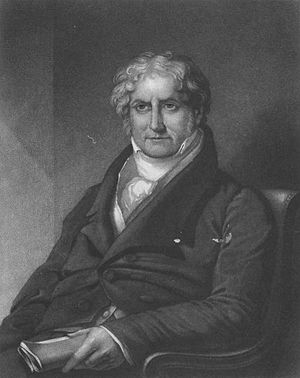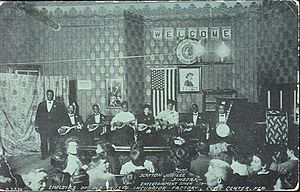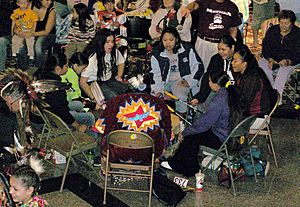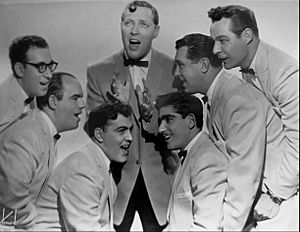Music history of the United States facts for kids
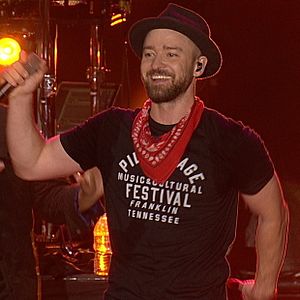
The music history of the United States is super rich and includes many different types of music! Think about folk, pop, and classical styles. Some of the most famous kinds of American music are blues, jazz, rock and roll, rock, hip hop, house, and country.
This amazing musical journey started with the Native Americans, who were the first people to live in North America. Their music was very diverse and often used for religious reasons.
Later, people from European countries like France, Spain, Scotland, England, Ireland, and Wales came to America. They brought Christian choirs, ways to write down music (called musical notation), and printed songs (called broadsides). Sadly, they also brought enslaved people from West Africa. These West Africans played many instruments, especially drums and string instruments like the banjo. The Spanish also had a similar instrument called the Bandora. Both African and Spanish cultures added cool musical ideas like polyrhythms (many rhythms at once) and call-and-response singing.
As the United States grew, more immigrants arrived, bringing their own instruments and music styles. This included Cajun and Creole music from Louisiana, Hawaiian music from Polynesia, and Tex-Mex and Tejano music. Immigrants also brought Eastern European polka, Chinese and Japanese music, Polish fiddling, Scottish and Irish music, Jewish klezmer, and other styles from India, Russia, France, Germany, Italy, Arab and Latin music.
In the 21st century, American popular music became famous all over the world. Even since the 1800s, with ragtime and minstrel songs, African Americans have had a huge impact on popular music. The blues from poor black Southerners and jazz from black city dwellers were some of the first popular American music styles. Over time, African American blues changed and led to genres like rhythm and blues. Jazz also grew and became more experimental, leading to styles like bebop and swing by the late 1940s.
Rock and roll soon became super important in American popular music, starting with rockabilly in the 1950s. In the 1960s, gospel music changed into soul. Rock, country, and soul mixed together and created many new styles over the next few decades, like heavy metal, punk, and funk. In the 1970s, young African Americans in New York City started speaking lyrics over a beat, which became hip hop music. By the early 2000s, hip hop was a big part of most recorded American popular music, and by the 2010s, more people were listening to hip hop than rock music!
Contents
American Roots Music: Where It All Began
The very first musicians in North America were Native Americans. They had hundreds of different groups, each with their own special folk music styles. Many of these musical traditions are now gone, but some, like Hawaiian music, are still strong today.
By the 1500s, many English, French, and Spanish settlers came to America, bringing new kinds of folk music. Then, Africans were brought as slaves, and they brought their music too. These Africans came from many different groups in West Africa. American music is a mix of African, European, and a little bit of Native American influences. Later, even more immigrants arrived from places like China, Japan, India, Scotland, Poland, Italy, Ireland, Mexico, Sweden, Ukraine, and Armenia, making the music even more diverse!
The first song to be officially protected by copyright under the new U.S. Constitution was "The Kentucky Volunteer". It was written by Raynor Taylor, an immigrant from England, and printed by Benjamin Carr, a major music publisher at the time.
African American Music: A Powerful Influence
In the 1800s, African Americans were freed from slavery after the American Civil War. Their music was a blend of Scottish and African styles. African American gospel music, for example, often had polyrhythms and other African sounds. Work songs and field hollers (songs sung while working) were popular, but it was spirituals that became a huge foundation for music in the 1900s.
Spirituals were Christian songs with strong, emotional singing, similar to Scottish church music. They used a call-and-response style, like a conversation between a singer and a group. These songs spread across the South in the early 1800s during a religious movement called the Great Awakening. After the Civil War, when black and white soldiers worked together, slave music became more popular, even among some white people.
By the late 1800s, minstrel shows were popular across the country and even in Europe. In these shows, performers pretended to be slaves in a silly way, singing and dancing to what they called "Negro music." But this music didn't sound much like real African American folk styles. An African American dance style called the cakewalk also became popular, and it later turned into ragtime by the early 1900s.
Appalachian Folk Music: The Roots of Country
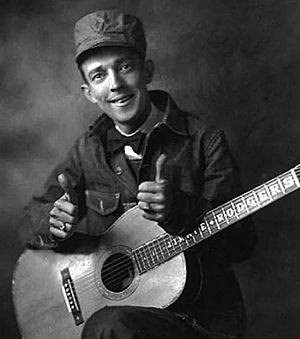
The Appalachian Mountains stretch along the East Coast of the U.S. This region was often poor. Many people from rural Appalachia moved to cities for work, where they were sometimes called hillbillies, and their music became known as hillbilly music. In the 1800s and early 1900s, many Irish and Scottish immigrants settled there, mixing with other poor white people and many black people. This mix created many different folk styles, now known as Appalachian folk music. These styles included jug bands, honky tonk, and bluegrass, which are the roots of modern country music.
Appalachian folk music started changing towards pop-country in 1927. That's when Jimmie Rodgers and the Carter Family began recording. Rodgers often sang sad songs about poor and unlucky people, using blues influences. The Carters preferred happier songs with clear singing and wholesome lyrics. Their success helped popular country music grow and also influenced early rock and roll.
Other American Roots Music Styles
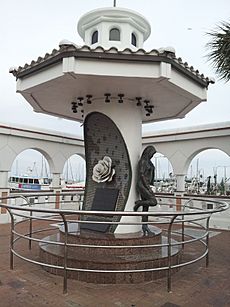
While Appalachian and African American folk music became the basis for much of American popular music, the U.S. is home to many other unique groups. In the early 1900s, many of these groups had their own small record industries and folk stars, like Pawlo Humeniuk, the "King of the Ukrainian Fiddlers." Some of these ethnic musicians became famous across the country, such as Frankie Yankovic, a Slovenian polka master.
This time also saw the rise of Native American powwows around the early 1900s. These were big gatherings for different tribes, featuring spiritual activities and music, mostly group drumming.
Many Eastern European Jews and their klezmer music came to the U.S. in the early 1900s. Musicians like Harry Kandel and Dave Tarras became stars in their community, making the U.S. a center for klezmer music.
In Texas, Mexican people who had lived there for centuries played a special style of conjunto music, different from what was played in Mexico. The influence of Czech polka music was a big part of this style, which slowly became known as norteño.
The Cajuns and Creoles of Louisiana have their own special culture and music. Cajuns are descendants of French-Canadians from Acadia, and Creoles are black and French-speaking. Their music was a mix of bluesy work songs, jazz, and other influences, including styles like la la and juré. These styles, though local, were updated and mixed with more popular music, turning into zydeco music by the mid-1900s.
The Start of Popular Music
The first type of American music that could be called popular, rather than classical or folk, was the singing of colonial New England choirs and traveling singing teachers like William Billings. This is where techniques like shape note singing and Sacred Harp were created. These ideas spread south and became a big part of the Great Awakening, a period of religious excitement in the 1730s and 1740s. During this time, emotional "Negro spirituals" became very popular among both white and black people.
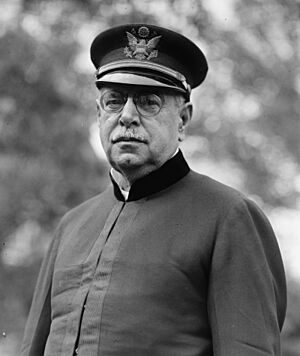
In the 1800s, it wasn't spirituals that became most famous, but rather lively, funny songs performed by minstrels in blackface (where performers painted their faces to look like black people). Famous songwriters like Stephen Foster wrote these songs. During the Civil War, popular ballads were common, often used as patriotic songs by both sides. Later in the century, the African American cakewalk dance evolved into ragtime, which became a huge hit in North America and Europe. At the same time, mainstream America loved the brass band marches of John Philip Sousa.
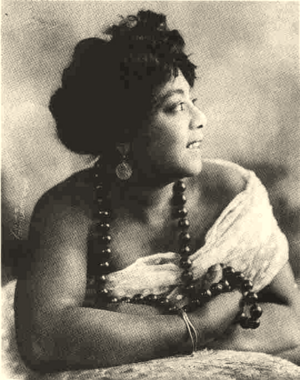
Tin Pan Alley was the biggest source of popular music in the early 1900s. It was a place in New York City where they published sheet music for dance songs. The first few decades of the 1900s also saw the rise of popular, funny musical theater, like vaudeville shows, and famous writers and composers like Oscar Hammerstein II, Jerome Kern, and Ira Gershwin. At the same time, jazz and blues, two different but related styles, started to become popular in cities like Memphis, Chicago, and New Orleans.
Blues and jazz were the foundation of what became American popular music. When people could buy recorded music on phonographs, the music industry changed. It became more about famous performers than just songwriters. There was more pressure to create big hits. Even small trends, like the Hawaiian steel guitar, left a lasting mark (the steel guitar is still very common in country music). Music from the Dominican merengue and Argentinian tango also influenced jazz. In the 1920s, classic female blues singers like Mamie Smith became the first national music stars. Gospel, blues, and jazz also grew, with new styles appearing in different cities.
Jazz quickly became more popular than blues in the form of big band swing, a type of dance music from the early 1930s. Swing used large groups of musicians and was usually not improvised, unlike other kinds of jazz. As swing spread, other music styles also became more popular. In Louisiana, Cajun and Creole music added blues influences and had some regional hits. Meanwhile, Appalachian folk music led to jug bands, honky tonk bars, and close harmony duets, which would later become the pop-folk, bluegrass, and country music of the 1940s. American popular music truly shows and shapes American society.
The 1940s and 1950s: Rock & Roll Begins
In the 1940s, jazz became more experimental with the bebop style. Country and folk music also grew, becoming more popular and respected.
The Birth of Rock & Roll
Starting in the 1920s, Boogie Woogie music began to change into what would become rock and roll. It had strong blues influences. Songs like "Crazy About My Baby" (1929) had early rock elements, and "Roll 'Em Pete" (1938) by Big Joe Turner had almost the complete rock and roll sound. Teenagers across the country started to connect through music, leading to new trends. Most importantly, the 1940s saw the rise of youth culture. The first teen stars appeared, starting with Frank Sinatra, which opened up popular music to young audiences, as it had mostly been for adults before the 1940s.
In the 1940s, boogie woogie music used words like "rocking" and "rolling," borrowed from gospel and blues, as in "Good Rockin' Tonight" by Roy Brown. In the 1950s, rock and roll musicians started covering boogie woogie and R&B songs. For example, Bill Haley and his Comets covered Big Joe Turner's "Shake Rattle and Roll" in 1954, and Elvis Presley covered Big Mama Thornton's "Hound Dog" in 1956. They also wrote their own songs, like Chuck Berry's "Maybellene" in 1955.
The Roots of Country Music
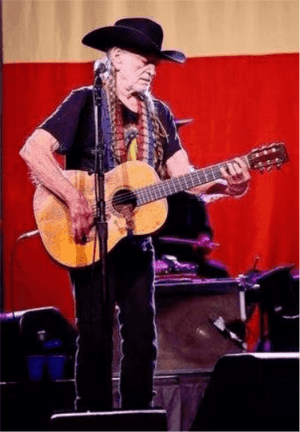
The early 1940s saw the first big commercial success for Appalachian folk music. Singers like Pete Seeger became famous in groups like the Almanac Singers and The Weavers. Their lyrics were inspired by early singer-songwriters like Woody Guthrie, and this music became linked with political ideas. By the 1950s, during a time of strong anti-Communism, some performers with liberal views were banned from the music industry.
In the mid-1940s, Western swing was at its most popular. It was a mix of different styles, including swing, blues, polka, and popular cowboy songs. Early stars like Bob Wills became some of the best-known musicians of that time.
Modern country music grew from a honky tonk base in the 1940s, mixing with R&B and the blues to form rockabilly. Rockabilly's first big stars were Elvis Presley and Bill Haley, who played to huge crowds of excited teenage fans. At that time, black audiences listened to R&B, doo wop, and gospel, but these styles were not seen as suitable for white listeners. People like Haley and Presley were white but sang in a black style. This caused a lot of concern among parents who worried that "race music," as it was then called, would be a bad influence on their children. Despite this, rockabilly's popularity kept growing, leading the way for early rock stars like Chuck Berry, Bo Diddley, Little Richard, and Fats Domino.
Among country fans, rockabilly wasn't very popular. Instead, the pop sounds of singers like Hank Williams and Patsy Cline became famous. Williams had amazing success, with more than ten songs reaching the top of the charts in just two years (1950–1951). His well-known songs like "I'm So Lonesome I Could Cry" and "Cold, Cold Heart" are still performed today. Performers like Williams made Nashville, Tennessee the center of the country music industry. There, country and pop music mixed, creating what was known as the Nashville Sound.
Gospel and Doo Wop: Vocal Harmonies
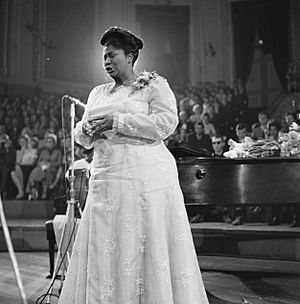
The 1950s also saw gospel music become widely popular, thanks to powerful singers like Mahalia Jackson. Gospel first reached international audiences in 1948 with Jackson's "Move on Up a Little Higher," which was so popular that stores couldn't get enough copies. As the music became more mainstream later in the decade, performers started adding influences from R&B to make it more appealing and dance-friendly. In the early 1960s, the lyrics became less religious, leading to soul music. Some of soul's biggest stars, including Sam Cooke, Dinah Washington, Dionne Warwick, and Aretha Franklin, started in the 1950s gospel scene.
Doo wop, a complex style of vocal music, also became popular in the 1950s and influenced 1960s soul and R&B. Its exact beginnings are debated, but it was inspired by groups like the Mills Brothers and The Ink Spots, who played a smooth R&B style with alternating lead singers. With gospel influences, doo wop's polished sound and romantic ballads became a big part of the 1950s music scene, starting in 1951. Early popular groups included The Five Keys ("Glory Of Love") and The Flamingos ("Golden Teardrops"). Doo wop became very diverse later in the decade, with groups like The Crows ("Gee") creating an uptempo doo wop style, and The Penguins ("Earth Angel") popularizing the ballad style. Singers like Frankie Lymon became sensations; Lymon was the first black teen idol in the country after his hit "Why Do Fools Fall in Love" (1956).
Latin Music: Rhythms from the South
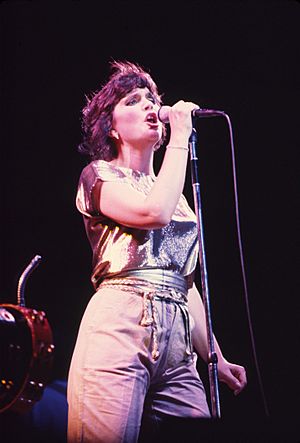
Latin music from Cuba (chachachá, mambo, rumba) and Mexico (ranchera and mariachi) had short periods of popularity in the 1950s. The first popular Latin music in the U.S. was rumba in the early 1930s, followed by calypso in the mid-40s, mambo in the late 1940s and early 1950s, chachachá and charanga in the mid-50s, bolero in the late 1950s, and finally boogaloo in the mid-60s. Latin music also mixed with jazz during this time, creating Latin jazz and the bossa nova fusion cool jazz.
The first Mexican-Texan pop star was Lydia Mendoza, who started recording in 1934. However, it wasn't until the 1940s that musica norteña became popular with female duets like Carmen y Laura and Las Hermanas Mendoza, who had many regional hits. The next decade saw the rise of Chelo Silva, known as the "Queen of the (Mexican) Bolero" for her romantic pop songs.
The 1950s brought more new ideas to the Mexican-Texan community. Electric guitars, drums, and elements of rock and jazz were added to conjunto music. Valeria Longoria was the first major conjunto performer, known for bringing Colombian cumbia and Mexican ranchera to conjunto bands. Later, Tony de la Rosa updated the conjunto big bands by adding electric guitars, amplified bajo sexto, and a drum kit, and by slowing down the fast dance rhythms. In the mid-1950s, bandleader Isidro Lopez used an accordion in his band, starting the evolution of Tejano music. The rock-influenced Little Joe was the first big star of this scene.
Cajun and Creole Music: Zydeco Takes Off
Louisiana's Cajun and Creole communities saw their local music become a brief mainstream trend in the 1950s. This was largely thanks to Clifton Chenier, who started recording in 1955. He took real Cajun and Creole music and added more rock and roll elements: a lively beat, energetic singing, and a danceable rhythm. The result was a style called zydeco. Chenier continued recording for over thirty years, releasing more than a hundred albums and opening the door for later stars like Boozoo Chavis and Buckwheat Zydeco.
The 1960s and 1970s: Music for Change
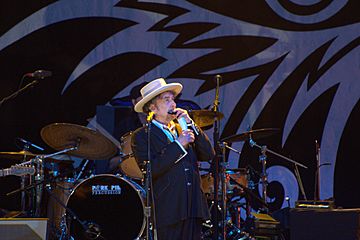
In the 1960s, music became deeply involved with the growing youth counter culture and various social and political causes. The early 1960s saw doo wop's popularity peak around 1961, along with the rise of surf, girl groups, and the first soul singers. Psychedelic and progressive rock appeared during this time, along with the beginnings of what would later become funk, hip hop, salsa, electronic music, punk rock, and heavy metal. An American roots revival (a return to older folk styles) happened at the same time as a period of social change and racial conflict. This led to popular music having more mature and complex lyrics, as songwriters wrote about the changes happening in the country.
Early 1960s: New Sounds Emerge
The first few years of the 1960s brought big changes to popular music. Girl groups, surf and hot rod music, and the Nashville Sound were popular. Meanwhile, an Appalachian folk and African American blues roots revival became popular with a smaller group of listeners. Even more young people in the United Kingdom listened to American blues. By the mid-1960s, British blues and R&B bands like The Beatles, The Who, and the Rolling Stones were topping the charts in what was called the British Invasion. At the same time, newly non-religious soul music and the Bakersfield Sound became mainstream. Folk-based singer-songwriters like Bob Dylan also brought new ideas to popular music, like making songs longer than the usual three minutes.
Psychedelic Rock: The Sound of a Generation

Psychedelic rock became the music most connected to youth culture. It grew out of the British Invasion of blues in the mid-1960s, when bands like The Beatles, Rolling Stones, The Yardbirds, and The Who were huge. Only a few American bands, like The Beach Boys and The Mamas & the Papas, could compete. Psychedelic rock became linked with hippies and movements against war, for civil rights, feminism, and environmentalism. This was similar to the rise of Afrocentric Black Power in soul and funk. Events like Woodstock became symbols for the Baby Boomer generation, who were born after World War 2 and grew up in the mid-to-late 1960s.
Later in the decade, psychedelic rock and youth culture split into different paths. Punk rock, heavy metal, singer-songwriter music, and progressive rock appeared. The strong connection between music and social activism mostly faded from popular music.
Some key places that promoted psychedelic rock included the Matrix, the Avalon Ballroom, Fillmore Auditorium, and the Berkeley Community Theater in San Francisco; The Family Dog Denver; the Grande Ballroom in Detroit; Whisky A-Go-Go and Kaleidoscope in Los Angeles; and Cafe Au Go Go in New York.
Soul and Funk: Grooves and Messages
From the 1960s to the 1970s, female soul singers like Aretha Franklin, and pop singers like Dionne Warwick and Diana Ross were popular. Meanwhile, amazing performers like James Brown created a new style of soul called funk. Influenced by psychedelic rock, which was popular at the time, funk was a very rhythmic, danceable kind of soul. Later in the 1970s, funk also split into two branches. Sly & the Family Stone made pop-funk popular for everyone, while George Clinton and his P Funk group created a new, psychedelic funk. In the 1970s, Kool & the Gang and the Ohio Players were also popular. Album-oriented soul also appeared very late in the decade and into the next, with artists like Marvin Gaye, Al Green, and Curtis Mayfield making soul music that was more than just singles. They created full albums with complex social messages.
It was in this environment, with album-oriented soul and funk, influenced by Black Power and the civil rights movement, that African Americans in Harlem invented hip hop music.
Country and Folk: New Sounds from Old Roots
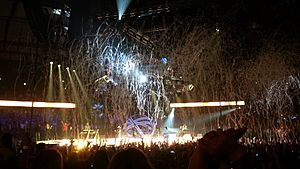
Merle Haggard led the rise of the Bakersfield Sound in the 1960s. This sound almost completely changed country music's main style and location in just a few years, as people felt the Nashville Sound was becoming too simple. At the same time, bluegrass became a big influence on jam bands like Grateful Dead and also developed into new, progressive styles like newgrass. As part of the nationwide roots revival, Hawaiian slack-key guitar and Cajun swamp pop also became successful.
Tejano Music: A Texas Blend
With the widespread success of Tony de la Rosa's big band conjunto in the late 1950s, the style became more influenced by rock and pop. Esteban Jordan's wild, improvised accordion style became popular, leading to the success of El Conjunto Bernal. The Bernal brothers' band sold thousands of albums and used faster rhythms than before.
The 1970s: Diverse Sounds Take Over
The early 1970s saw popular music dominated by folk-based singer-songwriters like John Denver, Carole King, and James Taylor. This was followed by the rise of heavy metal styles, glam, country rock, and later, disco. Philly soul and pop-funk were also popular, while mixes of world music became more common, and a big klezmer revival happened among the Jewish community. Starting in the early 1970s, hip hop grew in New York City, drawing from different influences like white and black folk music, Jamaican toasting, and the spoken word poetry of Gil Scott-Heron.
Heavy Metal: Loud and Powerful
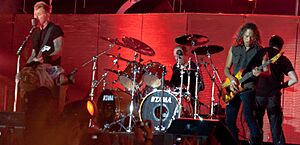
Early pioneers of heavy metal included British bands like The Yardbirds, Led Zeppelin, and Black Sabbath. American bands Blue Cheer and The Velvet Underground also played a big role. Their music was strong and bluesy, with an often intense sound that became even more noticeable in later styles. In the early 1970s, heavy metal-influenced glam rock appeared, and musicians like David Bowie became famous for their unique costumes and themes. Glam was followed by mainstream, big-sounding arena rock and lighter progressive rock bands becoming popular, with groups like Styx and Chicago having successful careers that lasted most of the decade. Glam metal, a flashy style of Los Angeles metal, also found a small audience but limited mainstream success.
Outlaw Country: Breaking the Rules
With the Bakersfield Sound being the main influence, outlaw country singers like Willie Nelson and Waylon Jennings were the biggest country stars of the 1970s. Alongside them were country rock bands like Lynyrd Skynyrd and Allman Brothers Band, who aimed for a wider audience. Later in the decade and into the next, these styles mixed with other genres, leading to heartland rockers like Bruce Springsteen. At the same time, a honky tonk revival hit the country charts, led by Dwight Yoakam.
Hip Hop: A New Urban Sound
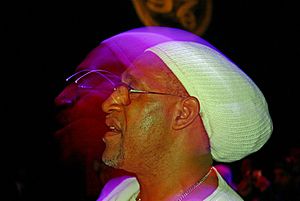
Hip hop was a cultural movement that began in Bronx, New York, in the early 1970s, with four main parts. Two of these, rapping and DJing, make up hip hop music. These two parts were brought from Jamaica by DJ Kool Herc. At neighborhood block parties, DJs would play popular records while people danced. Soon, an MC (Master of Ceremonies) started leading the party, as the DJ began to isolate and repeat the percussion breaks (the most popular, danceable parts of songs). The MCs' introductions became more and more complex, drawing on many African vocal traditions, and this became the foundation of rapping. By the end of the decade, hip hop had spread across the country, especially in Los Angeles and Chicago.
Salsa: Latin Rhythms in New York
Cuban and Puerto Ricans in New York created salsa music in the early 1970s. They used many different Latin American influences in the city's diverse melting pot. Puerto Rican plena and bomba, and Cuban chachacha, son montuno, and mambo were the biggest influences. Other influences came from Jamaica, Mexico, the Dominican Republic, Trinidad, Argentina, Colombia, and Brazil. Many early salsa musicians, like Tito Puente, had long careers in various Latin music styles. Salsa became very popular in the 1970s and for the next two decades, spreading to Venezuela, Colombia, Puerto Rico, Mexico, Peru, and especially Cuba.
Punk Rock: A Rebellious Spirit
Punk rock started as a reaction against the music that came before it. Early punks believed that greed had ruined American music, and they disliked the perceived arrogance of the biggest bands of the 1970s. It began in London and New York, with many local scenes by the end of the decade. Bands like Ramones and Patti Smith became very successful for their anti-mainstream style. However, it was the British band The Clash that became wildly popular, especially in the UK, and helped bring elements of punk into popular music in the 1980s.
The 1980s and 1990s: New Waves and Hip Hop Dominance
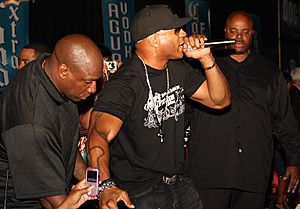
The 1980s started with new wave music being very popular. It continued with a new style of smooth soul music and ended with a popular glam metal trend dominating mainstream America. Meanwhile, punk rock started to gain some popularity, and new alternative rock and hardcore music found smaller audiences. Hip hop became more diverse as a few artists gained mainstream success, finally breaking through in the last few months of the decade.
Hip Hop: From Underground to Mainstream
In the 1980s, hip hop first tasted mainstream success with LL Cool J and Kurtis Blow. At the same time, hip hop continued to spread from the East Coast to most major cities across the country and even abroad. At the end of the decade, two albums pushed the genre into the mainstream: Public Enemy's It Takes a Nation of Millions to Hold Us Back and N.W.A's Straight Outta Compton. These albums were controversial for their sometimes strong lyrics. N.W.A was especially important, launching the career of Dr. Dre and the dominant West Coast rap sound of the next decade. That same year (1989), De La Soul's 3 Feet High and Rising became one of the first alternative hip hop albums. Many regional hip hop styles also became recognized, including Chicago hip house, Los Angeles electroclash, Miami's bass, Washington, D.C.'s go-go, and Detroit's ghettotech. Inspired by the rebellious spirit of the Civil Rights Movement, many smart and politically aware rappers started what is known as underground hip-hop, with artists like Boots Riley from The Coup leading the way.
The 1990s: Grunge, Gangsta Rap, and Pop
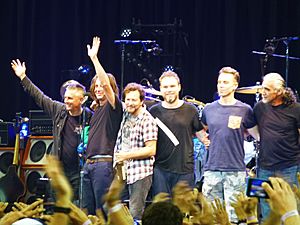
As the 1990s began, hair metal bands like Extreme were very popular. But in reaction to this, the first few years saw a big change in American popular music. Nirvana's Nevermind, along with Alice in Chains, Pearl Jam, and Soundgarden, launched the anti-mainstream grunge movement into mainstream audiences. At the same time, Dr. Dre's The Chronic brought his West Coast G Funk sound to widespread success.
However, both these trends faded quickly. Grunge ended partly due to Kurt Cobain's death and a feeling that grunge, an "alternative" rock style, had become too mainstream. G Funk lasted a few years, taking over from East Coast rap as the main hip hop sound. A rivalry grew, fueled by music news, focusing on West Coast's Tupac Shakur and the East Coast's Notorious B.I.G.. By the mid-1990s, Tupac and Biggie were tragically killed, and Dr. Dre's Death Row Records fell apart. East Coast rappers like Puff Daddy, 50 Cent, and Busta Rhymes brought the East Coast sound back, while Atlanta's OutKast and other performers found a mainstream audience.
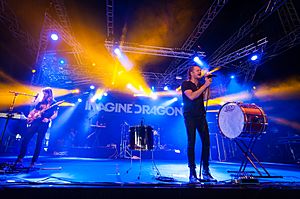
Alanis Morissette, one of the top-selling artists of the 1990s, brought new popularity to singer-songwriters like Tori Amos, Jewel, and Sarah McLachlan. After grunge and gangsta rap, a mix of soul and hip hop called neo soul became popular. There was also some popularity for British Britpop and the rise of bands like Sublime and No Doubt, who played a form of pop punk influenced by Jamaican ska and British two tone ska/punk from the early 1980s. Techno music also became popular, though not as much as in most other parts of the world.
At the start of the new millennium (the 2000s), bubblegum pop groups like Backstreet Boys and Britney Spears were topping the charts, many with a Latin beat (Shakira, Ricky Martin). Rappers like Jay-Z and Eminem were huge stars. Some garage rock revival bands like The White Stripes and The Hives became highly talked about in the indie rock world and achieved significant mainstream success. The first few years of the 2000s saw pop-hip hop grow even more, thanks to Eminem's breakthrough success. Indeed, hip hop became a key part of almost all popular music during this time, leading to new mixes like nu metal. Pop rappers like Ja Rule were nationally famous, though harder-edged hip hop made a comeback within a few years with the rise of 50 Cent. Politically aware hip hop, following the tradition of Public Enemy and Boogie Down Productions, has also become more diverse since the early 1990s with groups like The Coup, Sweatshop Union, Mr. Lif, Paris, Immortal Technique, and many others.
|


